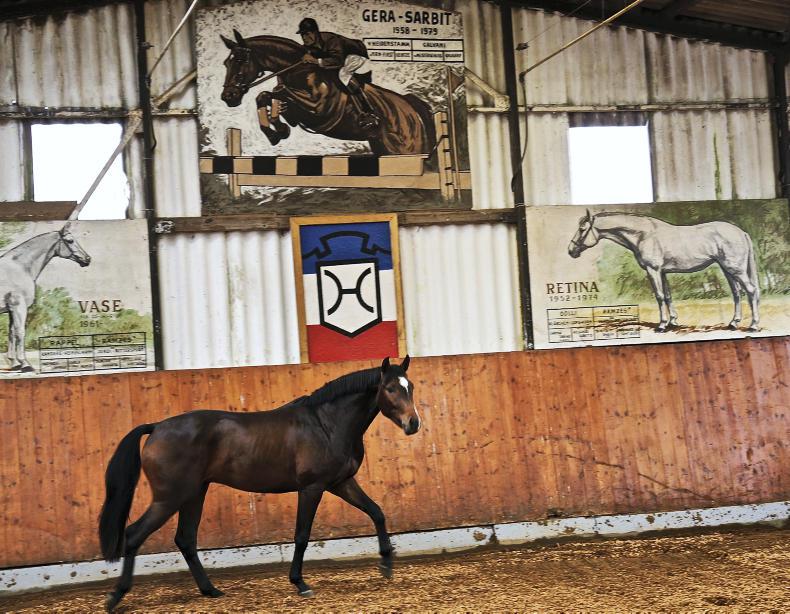HORSE breeding for some is a religion and a selection of devout followers gathered in Dublin Airport at an ungodly hour last Friday morning for the latest Teagasc equine overseas tour. Expertly organised by Wendy Conlon, whose inside knowledge of the Holstein breeders and fluent German proved invaluable, and Crea English, it was a whirlwind tour to the home of the Holsteiner horse.
Timed to coincide with the breed’s annual colt inspections and elite riding horse auction, the first two days was spent by the 24-strong Irish group at the Holstenhallen, an exhibition and concert venue, in Neumünster. This year’s colt candidates had already had a preliminary school in the transformed arena on Wednesday, before limb and movement at walk and trot assessment outdoors the following day.
By Friday, when the Irish Brigade arrived, it was a full house for the loose jumping element when spectators from home and overseas watched to see if they could spot the next new supersire or competition prospect. Blessed with not the best seats in the house and decoding announcements in German, it took us several minutes to match up each colt’s number to a superbly informative catalogue, worth every cent of its €13 price tag. However it was clear from several exuberant jumping displays, rewarded by a vocal audience, that there were some outstanding prospects for the inspectors to choose from.
This year’s panel included Dr. Thomas Nissen, Jens Hauschildt, Michael Gonell, Wulf-Hinrich Hamann and Christian Thoroe who oversaw a process, which ran like clockwork. The colts had already been assessed in August and October which was a benefit for them and so Friday’s loose jumping element was a final confirmation for the inspectors and another opportunity for prospective buyers to view this year’s batch.
On Saturday morning, colts were first shown individually by sprint-speed handlers and again, the German ‘clapometer’ flagged favourites, before being brought into the arena in small groups to stand in front of the inspector’s table for the decision. We soon recognised the “gekört” or “nicht gekört” verdicts or when one was awarded a premium, with the highest-marked colts scheduled to return later for the championship.
Early that morning, while walking around the stables, I’d spotted a photo opportunity of a laid-back sales entry having a snooze and recognised her again when the recharged Casall filly was the top-priced lot in the Elite riding horse auction. In another coincidence, this three-year-old was bred and consigned by Professor Dr. Hartwig Schmidt whose yard was on Sunday morning’s calling card.
Related to Carsten-Otto Nagel’s wonderful mare Corradina, she was sold for €150,000 to a Lower Saxony yard, while the second-highest price of €100,000 was paid by an Italian buyer for Nerrado Junior, by Nerrado. In all, 35 horses were sold at an average of €41,885, with the majority staying in Europe, including four event horse prospects going to the UK, and further afield including Dubai, Mexico and the United States.
TOP LOTS
With the champion colt results announced in reverse order, there was just Harm Thormählen’s Sandro Junior and Timm Peters’ Uno I remaining in the electric atmosphere of the arena as to which was this year’s champion. It was no surprise when Sandro Junior was the last colt standing as the dark bay son of Sandro Boy has been the crowd’s clear favourite over the two days and he was the first to go under the hammer in the auction, which immediately followed.

Sandro Junior, champion colt at the Holstein auction 2017 under the shadow of Holstein giants at the home of Harm Thormahlen
Again, it was noticeable how deftly-ran both the loose jumping and auction sections were carried out, with the 2017 champion bought by a breeding farm in southern Germany for €260,000.
The reserve champion will stay in Germany too as the Uriko-sired colt Uno I was bought by the Marbach stud for €96,000. Speaking of Marbach, where La Biosthetique Sam’s sire, the Irish export Stan The Man stood in his late years, Wendy Conlon’s announcement that she hoped to have a special guest speaker for the Irish contingent led to some frivolous guesswork.
Unsurprisingly, it proved to be neither Michael Jung or Angela Merkel but the Holsteiner Verband’s breeding director Dr. Thomas Nissen who generously gave his time during one of the busiest weekends of their year to share his frank views and costs of the selection process, plus the challenges facing this German studbook.
Those thoughts were often echoed over the next three days of fascinating visits to farms around the Holstein region to breeders interwoven with household names such as Cor de la Bryere, Capitol and Sacramento Song.
The heavy clay soil shaped the type of horse once produced in the Holstein region and these local breeders’ experiences over the decades both echoes and contrasts with their Irish counterparts. For example, filly foals are valued by Holsteiner breeders, as they are the next generation of carefully-curated mare lines and a fashionable stallion is not regarded as a ‘quick fix’ solution in one generation.
More common problems include the shortage of suitable riders for the breaking and production of young horses, thoroughbred-sired geldings are viewed as a by-product for the eventing market, while the Holstein and Irish breeders have also witnessed the rise of the Benelux breeding countries.
Next week: Walking in the shadow of giants
This has been my third Teagasc equine tour, which may seem odd for someone who has no involvement in show jumping, but I have always been intrigued as to why continental breeding is way more advanced in this sport. What better way but to go and visit and to experience their scientific method to breeding elite horses!
Repeat customer Jimmy Quinn